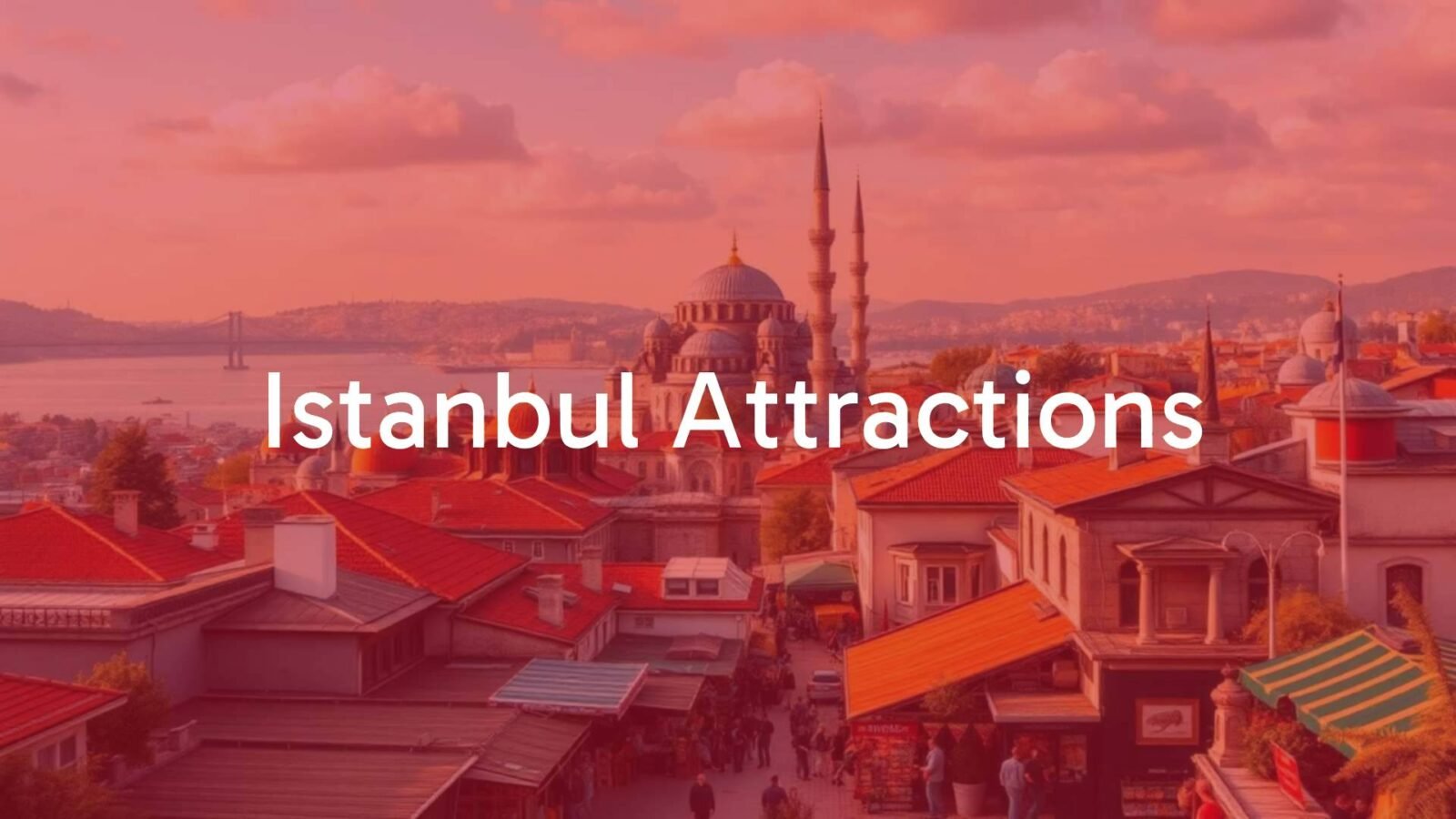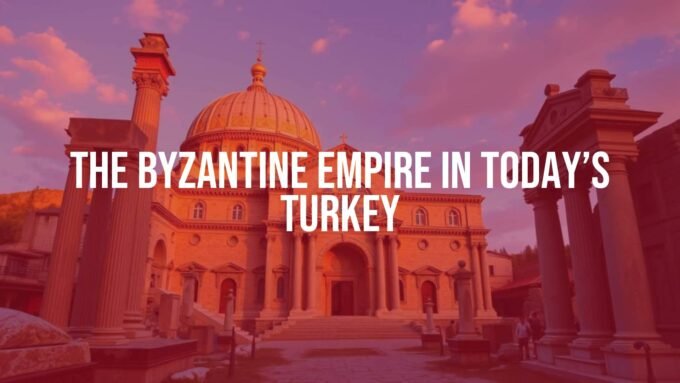Istanbul sits across two continents and mixes old and new in a way few cities can match. Spice scents from the Grand Bazaar meet the sea breeze from the Bosphorus, grand mosques rise over lively streets, and many corners still tell stories of past empires. From famous sights to quiet spots, Istanbul has places for every taste and budget, making it a great choice for any traveler.
This guide walks you through the best of Istanbul: its character, history, culture, and nature. You’ll also find practical tips to make your trip smooth and help you plan a clear itinerary for your time in this special city.
What makes Istanbul attractions unique?
Istanbul stands out because of its rare location and long, layered past. It was the capital of the Byzantine and Ottoman empires, leaving behind buildings and traditions that still shape daily life. The mix of East and West, old and new, gives the city a feeling you won’t find elsewhere.
The city feels alive at all times. Calls to prayer echo over the Bosphorus, and busy neighborhoods show both heritage and fresh energy. Istanbul is a treat for the senses and promises a trip you’ll remember.
How does Istanbul blend history and modern culture?
In Istanbul, history is part of everyday life. Byzantine churches and Ottoman palaces stand beside modern galleries and stylish cafes. Places like Hagia Sophia and Topkapi Palace still influence culture today.
Modern life builds on this base. Markets buzz, nightlife is lively, and food scenes grow fast. Spend the morning in ancient cisterns, sip Turkish coffee in Beyoğlu in the afternoon, relax in a Turkish bath, then enjoy dinner with a Bosphorus view. This easy mix of old and new keeps people coming back.
Why is Istanbul considered a city on two continents?
The Bosphorus Strait splits Istanbul into European and Asian sides. This natural waterway shaped the city’s past, culture, and look.
Most visitors start on the European side with Sultanahmet and Beyoğlu. The Asian side, with areas like Kadıköy, feels more local. Ferries cross all day, carrying people and goods and offering great views of this two-continent city.

Top historical attractions in Istanbul
Istanbul’s historic sites are its brightest stars. Palaces, mosques, and fortresses share the story of power, faith, and art across many centuries.
Hagia Sophia
The Hagia Sophia Grand Mosque is one of the world’s great buildings. Built as a cathedral in the 6th century by Emperor Justinian I, it was the largest building on earth for nearly 1,000 years. Its huge dome and mosaics showed the skill of Byzantine builders. After 1453, it became a mosque, then a museum in 1935, and returned to a working mosque in July 2020.
Non-Muslim visitors usually enter the upper gallery, reopened in January 2024. From there, you can see the dome, nave, and gold mosaics, along with a bronze door and Viking graffiti. Try to visit early or late to avoid crowds, as it follows set visiting times around prayers. Entry for foreign tourists is €25.
Blue Mosque (Sultan Ahmed Mosque)
Facing Hagia Sophia across a green square, the Blue Mosque (Sultan Ahmed Mosque) was built from 1609 to 1616 to rival the older church. Its name comes from the many blue Iznik tiles inside.
It has six thin minarets, rare for its time, which once caused comment since Mecca had the same number. Visitors are welcome, but remember it is a working mosque: remove shoes, and women should cover head and shoulders. Renovations continue, but its domes, courtyard, and calm mood make it a key stop. Entry is free; it closes to visitors during prayers.
Topkapi Palace
Topkapi Palace stands on a point above old Istanbul and was the home and seat of Ottoman rule for about 400 years. Built after 1453 by Mehmed the Conqueror, it is a wide complex of courtyards, gardens, and rooms for the royal family, state, treasury, and Harem.
Top sights include:
– Imperial Council Chamber
– Imperial Treasury with jewels and relics
– Marble Terrace
– The Harem’s rich rooms and stories
Arrive early and set aside half a day to see a lot. Views of the Bosphorus are excellent. Tickets start from $67; a combined ticket for the Palace, Harem, and Hagia Irene is 2000 lira (2025).
Basilica Cistern
Under the streets lies the Basilica Cistern, a huge 6th-century water store built by Justinian. It once supplied the Great Palace and later Topkapi. Its 336 marble columns and vaulted ceilings create a striking space.
Locals once fished through holes in basements before it was known again. Recent work added lighting and sound for a better visit. Check the two Medusa-head bases at the back. It’s cool in summer and appears in films, including a James Bond title. Tickets start from $36. Go early to skip long lines.
Dolmabahçe Palace
Dolmabahçe Palace shows the Ottoman move toward European styles in the 1800s. Built by Sultan Abdülmecid I, it became the royal home in 1856. Baroque, Rococo, and Neoclassical touches fill its rooms, with gilded ceilings, marble floors, crystal railings, and a 4.5-ton crystal chandelier given by Queen Victoria.
It marks the empire’s late, costly years, taking about a quarter of annual revenue at the time. The grounds hold many buildings and gardens. Photos are usually not allowed inside, but the scale and detail stand out. Bosphorus views are superb. Buy tickets on-site, and go early to avoid lines. Admission starts from $51.
Süleymaniye Mosque
Sitting on one of the city’s seven hills, the Süleymaniye Mosque is Istanbul’s largest and among its most beautiful and historic. Built for Süleyman “the Magnificent” and finished in 1557, it is a masterwork by architect Mimar Sinan, with perfect balance, a vast interior, and four slim minarets.
It also offers one of the best views over the Bosphorus and Golden Horn. The complex has a quiet courtyard, lawns, and a rose-filled cemetery. It’s often less busy than the Blue Mosque. Entry is free, but it closes during prayers. Usual visiting times: 9:00-12:30 and 13:45-15:45; avoid Fridays until 2:30 pm.
Galata Tower
Galata Tower, built by the Genoese in 1348, is a favorite symbol of the city. Used as a lighthouse, observatory, and fire tower in the past, it now gives 360-degree views of the historic peninsula, Golden Horn, and Bosphorus.
Sunset and nighttime views are great, though lines can be long and tickets cost about €30 (2025). The streets around the tower are full of cafes and shops. Many people enjoy photographing the tower from nearby lanes like Büyük Hendek Street. Visit early morning or late evening for fewer crowds.
Chora Church (Kariye Museum)
Near the old walls in Edirnekapı, the Chora Church (Kariye Museum) is known for bright Byzantine mosaics and frescoes. The church dates to the 11th century, with most art from the 14th century. The scenes show early Christian stories with vivid detail.
It has been a monastery church, mosque, and museum. It was made a mosque again in 2020, then reopened as Kariye Museum in May 2024, with restored Christian art open to visitors outside a small prayer hall. Entry is €20; open daily 9 am-6 pm. It’s quieter than central sites and worth the trip.
Rumeli Fortress
Rumeli Fortress stands on the European Bosphorus shore. Built by Mehmed the Conqueror in only four months (1451-1452), it was important in the siege that led to the fall of Constantinople. Set at the narrowest point, it blocked aid from the Black Sea.
Today, you can explore its courtyards and see its strong walls. The museum and wall-top deck are closed for work in 2025. It’s a calm stop away from main routes. Entry is €7; open 9 am-7 pm daily except Wednesday.
Theodosian Walls and Yedikule Fortress
Built in the 5th century by Theodosius II, the Theodosian Walls defended Constantinople for over a millennium. They held back many attacks until 1453, when Ottoman cannons broke through.
At the southern end, Yedikule Fortress (Seven Towers) grew from two of these towers into a grand citadel. Parts of the walls vary in condition, but walks here give a strong sense of history and the city’s old strength. From Yedikule’s walls, you can watch ships moving along the Bosphorus.
Best cultural experiences and city tours
Istanbul’s culture is best felt by joining in. Boat rides, walking tours, baths, and food trips help you connect with daily life.
Bosphorus cruise options
A Bosphorus cruise gives wide views of the skyline and waterfront mansions. You can choose a public ferry or a dinner cruise. From the water, palaces, parks, and wooden yalıs look their best.
- Budget option: commuter ferry (Eminönü-Kadıköy). About 20 minutes and around 38.11 lira.
- Longer tourist ferries head toward the Black Sea for more sights.
- Dinner cruises with shows cost about €40 per person.
- Sunset yacht trips offer snacks and drinks.
Skip summer weekends for Princes’ Islands or long Bosphorus rides if you want fewer crowds.
Guided walking tours
Guided walks help you learn stories behind the stones, find small details, and move through the streets without stress. Many companies offer themes for different interests.
For a first visit, a full-day private tour of Hagia Sophia, Blue Mosque, and Topkapi can save time with skip-the-line entry and clear stories about each place. Other walks cover Balat and Fener, with old churches, synagogues, and street art. Good guides share local tips you might miss on your own.
Traditional Turkish bath (hamam) experiences
A hamam visit mixes rest and tradition. You sit in steam, get a scrub (tellak for men, natir for women), a soap massage, then relax.
Top choices include Kılıç Ali Paşa Hamamı (Tophane), Zeyrek Çinili Hamam (Fatih, with a small museum), and Ayasofya Hürrem Sultan Hamamı (Sultanahmet). Packages range from basic scrubs to full treatments. Some offer private rooms, others are communal. It’s a great way to relax after sightseeing. Prices vary; for example, Istanbul Gedikpasa Historical Turkish Bath with Privacy Option starts from $61 per adult.

Culinary tours and local food tasting
Food is a highlight in Istanbul. A guided food tour lets you try street snacks and sit-down dishes while walking different areas.
Popular picks:
– Istanbul Taste of Two Continents Food Tour – Spice Market & Ferry
– Taste the Flavors of Istanbul Kadıköy Food Tour
– Hidden Beyoğlu Tour
Try simit, roasted chestnuts, and balik ekmek from Eminönü boats. Don’t miss a full Turkish breakfast (serpme kahvaltı). For sweets, visit Hafiz Mustafa 1864 for baklava. These tours also share the stories behind each dish.
Iconic markets and shopping destinations
Istanbul’s markets are cultural centers as much as places to buy things. They are loud, colorful, and full of life, and they are great for finding gifts and local goods.
Grand Bazaar
The Grand Bazaar (Kapalı Çarşı) dates to 1461 and covers 66 streets with over 4,000 shops, selling carpets, jewelry, ceramics, leather, spices, and more. It’s one of the city’s busiest sights.
Bargaining is part of the fun. Prices can be high, and locals sometimes skip it, but the setting and history are worth a look. If you want a carpet, the choice here is huge. Even a short 15-minute visit gives a sense of its energy. Open Monday-Saturday 9 am-7 pm; closed Sunday.
Spice Bazaar (Egyptian Bazaar)
Near Eminönü is the Spice Bazaar (Mısır Çarşısı), built in 1660. It’s famous for spices, herbs, and Turkish delight, once the empire’s main center for medicinal herbs and spices.
Today you’ll find teas, nuts, dried fruits, baskets, and gifts. It feels easier to move through than the Grand Bazaar. Look for colorful spice displays, and try samples if offered. Open Monday-Saturday 8 am-7:30 pm; Sunday 9:30 am-6 pm.
Arasta Bazaar
Behind the Blue Mosque, Arasta Bazaar is smaller and calmer. It keeps the feel of an Ottoman arcade and sells carpets, Iznik tiles, pottery, jewelry, and textiles.
Shops focus on quality, and owners often know their craft well. The Museum of Great Palace Mosaics is here too, adding history to your visit.
İstiklal Avenue and Taksim Square
İstiklal Avenue, a busy pedestrian street, runs about 1.4 km from Taksim Square to near Galata. You’ll find big-brand stores, local shops, old buildings, cinemas, theaters, and galleries, plus a nostalgic red tram.
At night the area comes alive with bars and restaurants. Taksim Square is a major meeting point and transit hub. While the square itself is simple, the energy on and around İstiklal makes it a must-see for modern Istanbul.
Natural and scenic attractions around Istanbul
Beyond crowded streets and big monuments, Istanbul has calm places with trees, water, and views. These spots give a nice break during your trip.
Princes’ Islands
The Princes’ Islands (Adalar) in the Sea of Marmara are car-free and quiet. Four main islands welcome visitors: Büyükada, Heybeliada, Burgazada, and Kınalıada. You can walk, bike, or ride a horse-drawn carriage.
Büyükada is the largest, with early 20th-century villas covered in bougainvillea. Rent a bike (around 5 TL per hour), hike, or relax at a beach. Burgazada is a calmer pick. Ferries from both sides of the city take 1.5-2 hours and offer wide views of Istanbul. Try to go on weekdays to avoid weekend crowds.
Gülhane Park and city gardens
Next to Topkapi Palace, Gülhane Park is a green space that once belonged to the sultan. Its name means “house of roses.”
Today it’s popular for walks and picnics, with tall plane trees, flowerbeds, fountains, and Bosphorus views. Pair a palace visit with time in the park. Across the city you’ll also find small gardens for short rests in nature.
Yıldız Park and Emirgan Grove
Yıldız Park in Beşiktaş covers 46 hectares and was once a royal hunting ground. Expect leafy paths, arbors, and picnic spots-an easy escape from city noise.
Farther up the Bosphorus, Emirgan Grove hosts the International Tulip Festival every April, with millions of tulips in many varieties. It has lakes, a waterfall, and restaurants, and is nice year-round for long walks and quiet time.
Pierre Loti Hill and Golden Horn viewpoints
Pierre Loti Hill gives wide views over the Golden Horn and old Istanbul. Take the Eyüp cable car up for a scenic ride.
At the top, the Pierre Loti Café and gardens are great for tea or coffee with a view. Sunsets are especially good for photos.
Bosphorus shore walks
Walks along the Bosphorus are simple and rewarding. On the European side, Arnavutköy has a lovely path and Ottoman mansions (yalı). Fishermen often line the shore.
On the Asian side, the Üsküdar embankment and Kadıköy parks have excellent sunset views with the Maiden’s Tower and European skyline. Stop for tea, watch the ferries, and enjoy the sea air.
Unique and Instagrammable places in Istanbul
Istanbul is full of photo-friendly places, from seaside towers to colorful streets. These spots mix history and style for great shots.
Maiden’s Tower (Leander’s Tower)
The Maiden’s Tower (Kız Kulesi) sits on a small islet off the Asian shore. Over time it has been a watchtower, customs post, lighthouse, and quarantine site. Today it has a restaurant and museum.
Many people enjoy the view from the Üsküdar embankment. Locals sit on cushions, drink tea, and feed seagulls with the tower behind them. Sunset light makes especially pretty photos.
Colorful houses in Balat and Fener
Balat and Fener once housed Jewish and Greek Orthodox communities. Their narrow lanes have wooden houses painted bright red, blue, yellow, and green.
Balat is now popular for photos, with cozy bars, vintage shops, quirky cafes, and rainbow stairs. You’ll also find the Patriarchate of Constantinople, the Church of St. Mary of the Mongols, and the Greek Orthodox College. Expect many chances for lively, colorful shots.

Ortaköy Mosque and Bosphorus Bridge views
Ortaköy Mosque (Büyük Mecidiye) sits right on the water. Its Baroque style pairs with the Bosphorus Bridge behind it for an iconic scene.
Photographers love the pier’s “special” ledge for the best angle. Go early morning or on a quiet day to avoid crowds. The Ortaköy waterfront has cafes and street food, adding to the fun.
Kamondo Stairs and Galata neighborhood
The Kamondo Stairs connect Karaköy and Galata. Built in 1860 by the Kamondo banking family, their art nouveau curves make a striking backdrop.
Climb into Galata’s cobbled streets, boutiques, galleries, and cafes, with Galata Tower above. Early morning light works well for photos with fewer people around.
Natural and scenic attractions around Istanbul
Outside the busy center, you’ll find quiet islands, parks, and viewpoints that make great day escapes.
Princes’ Islands
The Princes’ Islands offer calm streets with no cars, pine woods, old mansions, and beaches. Büyükada is the largest and most active; Heybeliada and Burgazada are quieter.
Ferries leave from Eminönü and Kabataş (Europe) and Kadıköy and Bostancı (Asia). The ride takes 1.5-2 hours and shows off the skyline. Weekday visits bring smaller crowds.
Gülhane Park and city gardens
Gülhane Park in Sultanahmet is green, central, and easy to reach after Topkapi. Paths, fountains, big trees, and flower beds make it a pleasant place to pause, especially in spring when tulips bloom.
Across the city, smaller parks offer short breaks from busy streets and markets.
Yıldız Park and Emirgan Grove
Yıldız Park in Beşiktaş is a large wooded park with ponds and pavilions. It draws families and walkers, especially on weekends.
Emirgan Grove hosts the tulip festival in April and stays lovely the rest of the year with lakes and picnic areas. Both parks give wide views and a calm setting.
Pierre Loti Hill and Golden Horn viewpoints
Pierre Loti Hill looks over the Golden Horn and old mosques. Ride the cable car from Eyüp for an easy climb.
At the top, enjoy tea at the café and watch the city glow at sunset. It’s a quiet, scenic spot for photos.
Bosphorus shore walks
Strolls along Bebek, Arnavutköy, and Yeniköy on the European side pass wooden mansions, cafes, and fishing spots. Watch ships and ferries move along the strait.
On the Asian side, Üsküdar and Kadıköy shorelines are popular for evening walks and picnics with sunset views. The sea breeze and constant movement of boats make these walks memorable.
Unique and Instagrammable places in Istanbul
Beyond famous monuments, many corners of the city are perfect for photos and short stops.
Maiden’s Tower (Leander’s Tower)
The Maiden’s Tower near Üsküdar is small, elegant, and wrapped in legends. It looks great at sunset.
Many people prefer shooting from shore, where the tower lines up with the bridge and busy water traffic for dramatic scenes.
Colorful houses in Balat and Fener
Balat and Fener offer narrow cobbled streets, bold paint colors, and daily life scenes-laundry lines, cats, and coffee breaks. Cafes and vintage shops add charm and style for your photos.
Ortaköy Mosque and Bosphorus Bridge views
Ortaköy Mosque’s ornate design and the bridge behind it make a classic Istanbul image. Use the pier for the best angle and go early for fewer people.
Kamondo Stairs and Galata neighborhood
The Kamondo Stairs’ flowing lines stand out in photos. From there, wander Galata’s creative streets up to the tower for more photo spots and street scenes.
Day trips and attractions beyond the city center
The wider area around Istanbul has forests, villages, and beaches that are easy to reach and make good day trips.
Belgrad Forest
Belgrad Forest lies a short drive from town. In the past, aqueducts carried its water to the city; today, it’s a large park with walking paths and lakes.
Old oaks dominate, with eastern birch, hornbeam, and chestnut also common. Birds are plentiful, and you might spot foxes, boars, or deer. Jog, hike, or picnic in quiet surroundings.
Polonezköy village
On the far east of the Asian side, Polonezköy is a Polish village from the 19th century. People still keep Polish traditions and language alongside Turkish.
Expect meadows, forest, and wooden houses. Rent bikes, take gentle walks, and try local honey and cherries. The “Cherry Festival” runs around June 16-17. It’s a peaceful rural break close to the city.
Beach destinations near Istanbul
For summer heat, Black Sea beaches near Istanbul are good for a day out. The water is cooler than the Mediterranean, which many find refreshing.
Kilyos is easy to reach by metro and bus, with sandy beaches and a lively feel in summer. Şile is farther, with beaches, a lighthouse, and a small-town vibe. Both offer swimming, sun, and fresh seafood.
Sile and Agva coastline
Şile has a tall lighthouse, beaches, and traditional homes. It’s a calm place to swim and eat fish near the water. There’s also a small castle and a cave to see.
Ağva sits between two rivers that flow into the Black Sea. You’ll find river cruises, canoeing, hiking, and quiet guesthouses. The drive passes forests and villages and makes a nice day out.
Where to stay for easy access to Istanbul attractions
Your base can shape your trip. Pick an area that matches your plans and style of travel.
Historic center (Sultanahmet)
If you want to see the main sights on a short trip, stay in Sultanahmet. Hagia Sophia, Blue Mosque, Topkapi, and the Basilica Cistern are all close. The area is a UNESCO World Heritage site with pretty streets and cafes.
It’s touristy and can be pricey, but choices exist for many budgets. The tram is close by, so you can reach other areas easily. Staying here saves time and puts you near the big highlights.
Beyoğlu and Galata areas
For a modern feel with shops, dining, and nightlife, choose Beyoğlu around İstiklal Avenue, or Galata below the tower. You’ll find art spaces, theaters, and trendy cafes.
Galata has cobbles, old buildings, and boutique hotels, plus views over the Golden Horn. It takes a short tram ride or walk to reach Sultanahmet, but the energy and food scene make it a strong pick-especially for longer stays.
Asian side accommodations
For longer trips or a local vibe at a lower cost, stay on the Asian side. Kadıköy and Üsküdar are top choices. Ferries and the Marmaray Tunnel connect both sides well.
Kadıköy is a busy center with cafes, markets, street food, bookstores, and parks. Üsküdar has a pretty waterfront, mosques, and a more traditional feel, with great views of the European skyline. Prices are often lower here, and you’ll see daily life up close.
Practical tips for visiting Istanbul attractions
Getting around a big, historic city like Istanbul is part of the fun. A few simple tips help keep things smooth and low-stress.
Best times to visit major sites
Go early or late in the day to avoid mid-day crowds at Hagia Sophia, Blue Mosque, Topkapi Palace, and the Basilica Cistern, especially from May to August.
Mosques close to visitors during prayers. Check prayer times ahead, and avoid midday Friday visits. For Galata Tower, sunrise or evening brings smaller lines and great light.
Using public transport and ferries
Istanbul’s buses, trams, metro, and ferries make travel easy and affordable. Buy an Istanbulkart and top it up at kiosks and machines; fares are cheaper than one-off tickets.
- Trams are handy for Sultanahmet and nearby areas.
- Metro lines are quick for longer distances.
- Ferries offer scenic rides between continents at low cost.
- In the metro, each line change costs a new fare; Istanbulkart reduces the price with transfers.
- Taxis are common but can be pricey; locals often use BiTaksi.
Safety and visitor guidelines
Istanbul is generally safe, but pickpocketing can happen in crowded places like the Grand Bazaar and on busy transport. Keep bags closed and phones secure. Solo travelers should be careful with strangers who offer drinks or invite them to bars at night.
Dress modestly for mosque visits: women should cover head, shoulders, and knees; men should avoid shorts. Scarves and skirts may be provided, but bringing your own speeds things up. Stay quiet during prayers, don’t use flash, and remove shoes. For SIM cards, city shops are usually cheaper than the airport; bring your passport for setup.
Museum Pass and ticket options
To save time and possibly money, buy tickets on the official site muze.gov.tr for major spots like Hagia Sophia, Basilica Cistern, and Topkapi Palace. The Istanbul Museum Pass covers several places and lets you skip lines. It’s valid for five days from activation and costs about €105; buy online or at kiosks near key sites.
Keep in mind: Dolmabahçe Palace tickets are usually sold on-site only; go early to avoid long lines. Some places have different rules or prices for tourists and locals. Check official websites for prices, hours, and rules before you go. For a broader option, the Istanbul E-pass covers 60+ attractions, guided tours, and activities for 2, 3, 5, or 7 days.
Final recommendations for planning your Istanbul attractions itinerary
Give yourself time to wander. Don’t try to see everything at once. Getting pleasantly lost in a lively neighborhood, finding a quiet tea garden, or lingering at a Bosphorus cafe can be the best parts of your trip.
Mix famous sights with daily life. See ancient mosaics in the morning, then visit a market to bargain and try street food in the afternoon. Spend time on both the European and Asian sides; ferries are part of the experience and offer some of the best views. Add a hamam visit for rest between busy days. Talk with locals, stay curious, and let the city show you its many layers at an easy pace.














Leave a comment